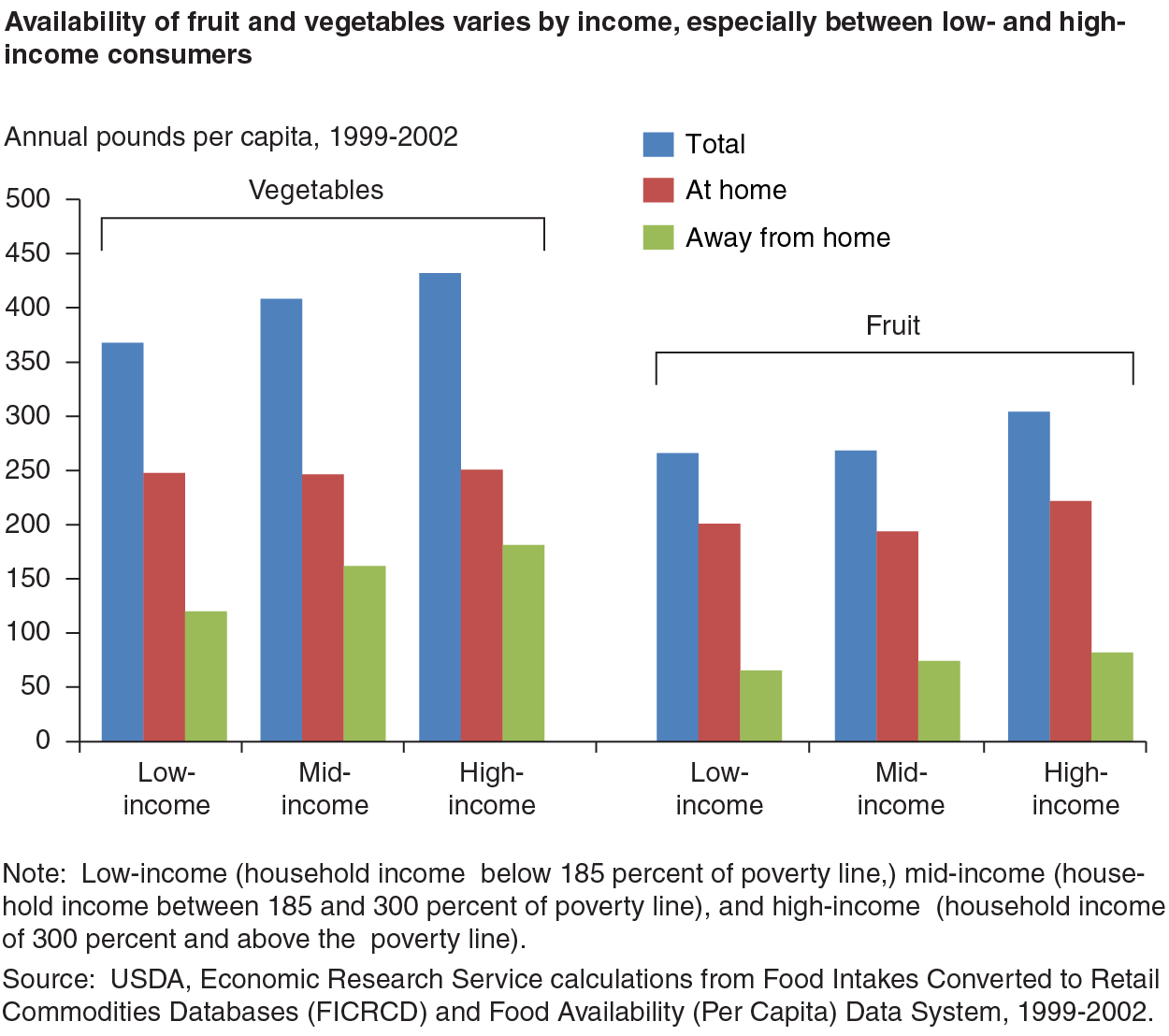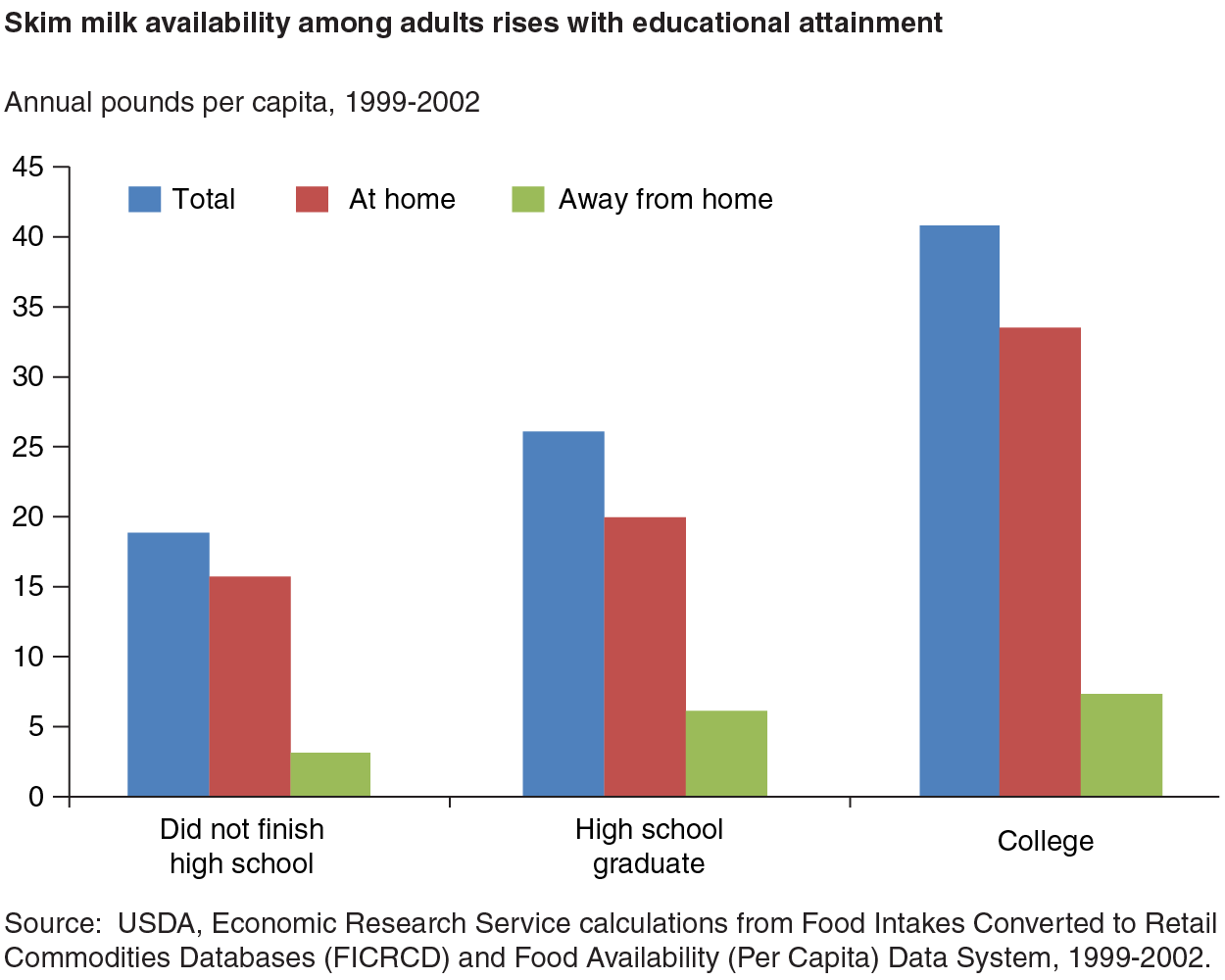New ERS Data Product Links Food Availability and Food Intake Data
- by Biing-Hwan Lin and Carolyn Rogers
- 2/21/2013
Who eats what, where, and how much? These are questions of interest to many--health professionals, farmers, food companies, policymakers, and others. By linking national estimates of food supplies, or food available for consumption, with information from consumer food intake surveys, ERS’s recently updated Commodity Consumption by Population Characteristics data product can provide some answers.
ERS annually tracks national supplies of several hundred commodities and expresses this food availability (a proxy for consumption) on a per person basis. However, these national averages cannot be broken down by age, income, educational attainment, or other sociodemographiccharacteristics of consumers, or by whether the food came from a grocery store or an eating place outside the home. The National Health and Nutrition Examination Survey (NHANES) conducted by the U.S. Department of Health and Human Services and USDA collects individuals’ self-reported food intake data along with source of food and demographic information. Researchers can use the NHANES data to break down the national availability statistics by different population characteristics and where the food was prepared. To estimate quantities consumed of mixed foods, such as apple pie or beef lasagna, researchers need to convert these items back into their commodity components.
USDA’s Agricultural Research Service and ERS jointly developed a set of conversion factors to translate mixed foods reported in NHANES into commodities. This conversion enables researchers to calculate intake averages for each commodity for different demographic groups. In the Commodity Consumption by Population Characteristics data product, these averages are applied to ERS’s food availability data for the 1999-2002 period, providing availability estimates disaggregated by household income, age, gender, race and ethnicity, educational attainment, body weight status, and source of food. A sampling of findings from this data product follows.
Consumption of Fruit and Vegetables Rises With Income
People living in low-income households consumed smaller quantities of both fruit and vegetables than high-income people during 1999-2002. For example, per person availability of vegetables was 368 pounds per year for low-income individuals during the period, 408 pounds for middle-income individuals, and 432 pounds for high-income individuals. While the bulk of fruit and vegetables are consumed at home, high-income households consumed a higher share of food away from home than low-income households. High-income households consumed 42 percent of vegetables and 27 percent of fruit in away-from-home eating places, while low-income households consumed33 percent of vegetables and 25 percent of fruit away from home.
Milk Consumption Correlates With Educational Attainment
Consumption of milk, especially skim milk, was found to be greater for those with higher levels of education. Adults who attended college consumed 19 percent more milk in 1999-2002 than those who did not finish high school. Per capita availability of skim milk among college-educated adults (41 pounds, or 4.7 gallons, per year) was more than double that of those who dropped out of high school (19 pounds, or 2.2 gallons, per year).
Applying intake patterns from NHANES to ERS’s 1999-2002 food availability data shows that younger children consume more milk than older children. Per capita availability of milk was 312 pounds (36.2 gallons) per year for boys age 2-11, compared with 291 pounds (33.8 gallons) for boys age 12-19. Girls displayed a similar pattern with per capita availability dropping from 263 pounds (30.6 gallons) for girlsage 2-11 to 192 pounds (22.3 gallons) for girls age 12-19.
Children Consume More Apples Than Adults
Per capita availability of apples during 1999-2002 was 67 pounds a year for boys age 2-19 and 71 pounds for girls age 2-19. Per capita apple availability was 33 pounds per year for women and 37 pounds for men. Apple consumption among children is mainly in the form of apple juice. Fifty-six percent of apple consumption among children came from apple juice, compared with 42 percent for adults.
Black Americans Favor Consumption of Meats, Poultry, and Fish
Black Americans were found to consume larger amounts of pork, chicken, turkey, and fish than other racial groups. Beef consumption was highest for Hispanics, at 75 pounds a year. Per capita availability of beef, pork, poultry, and fish for Blacks was 236 pounds per year, compared with 191 pounds per year among Whites. Hispanics consumed larger amounts of eggs than other racial or ethnic groups.
This article is drawn from:
- Commodity Consumption by Population Characteristics. (n.d.). U.S. Department of Agriculture, Economic Research Service.
You may also like:
- Food Availability (Per Capita) Data System. (n.d.). U.S. Department of Agriculture, Economic Research Service.




